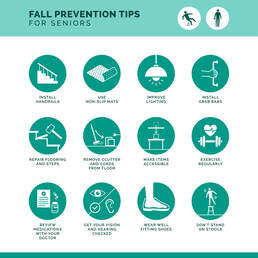The link between vision and fallsFalls can lead to a variety of injuries, such as broken bones. Falls may also cause a decrease in mobility and a loss of independence. Fall risk increases as we age for a few reasons. Core and leg strength may decrease as we get older. Balance also tends to become worse in our 50s and beyond. But vision also plays a role in our risk of falling. Studies show a strong relationship between a decrease in visual acuity and an increase in fall risk. According to the CDC, having poor vision doubles a person’s risk of having a fall. Vision also affects balance control. If vision decreases with age, it may also lead to poor balance and increased fall risk. Visual impairment also may reduce postural stability, which also increases the risk of falling. How to improve vision issuesWe might not be able to prevent all the changes that can occur with our vision as we age, but there are ways to keep your eyes healthy and deal with vision issues as you get older. Consider the following: Get regular eye exams: Getting regular eye exams can help identify common eye problems and diseases early. For example, early diagnosis of glaucoma can reduce the risk of vision loss if appropriate treatment is given. Regular eye exams also help spot vision changes that are correctable with glasses. Wear appropriate glasses or contact lenses: If you have glasses, wear them as prescribed. Being unable to see clearly will increase the chances that you will take a tumble. See a neuro-rehabilitative eye specialist: For people that have low vision, a neuro-rehabilitative eye specialist may develop therapy protocols that enhance vision as much as possible, which may decrease fall risk. General fall prevention tipsIn addition to maintaining healthy eyes, there are several ways to prevent falls, such as:
Use good lighting: Poor lighting can make it difficult to see and might be a tripping hazard. Install bright lights in areas where tripping is more likely to occur such as in narrow hallways and stairways. Remove clutter and tripping hazards: Remove clutter that is easy to trip on. For instance, remove electrical cords from hallways, secure rugs, and repair loose floorboards. Install handrails and grab bars: Install handrails for all stairways, outdoor decks, and bathtubs. Know your limits: Recognize when something is too challenging for you to do without risking a fall. Practice balance exercises: Practicing balance exercises helps with muscle memory. Practice easy exercises, such as standing on one foot or shifting your weight from side to side. Use non-slip mats: Place non-slip mats in areas, such as the bathroom, porch and kitchen. By taking some of the steps above, you can decrease your risk of having a fall. If you have any questions on vision and falls, we are happy to help. Also, if you would like to ask whether an appointment with one of our eye doctors would be appropriate at this time, call our office at 508-746-8600. Comments are closed.
|
EYE HEALTH BLOGCategories
All
Archives
July 2024
|
|
Kadrmas Eye Care New England
55 Commerce Way, Plymouth, MA 02360
14 Tobey Road, Wareham, MA 02571 133 Falmouth Road (Rt 28), Mashpee, MA 02649 |
Phone Number:
1-508-746-8600 Hours: Monday through Friday — 8 AM – 4:30 PM |


 RSS Feed
RSS Feed
